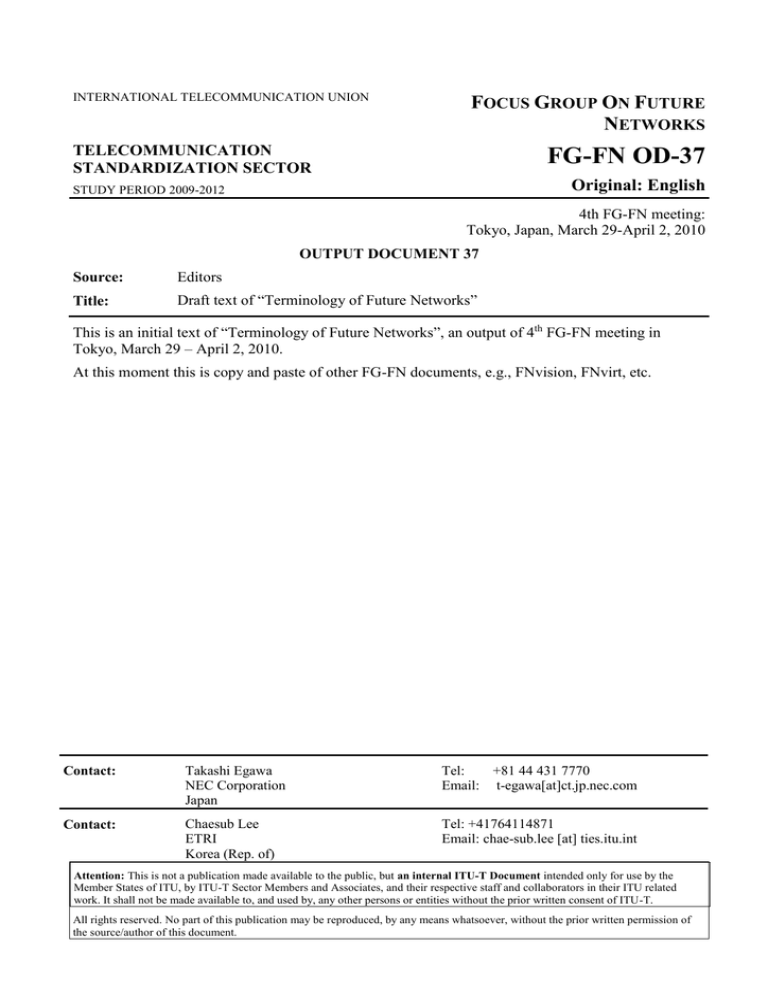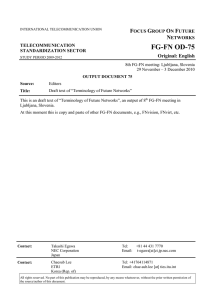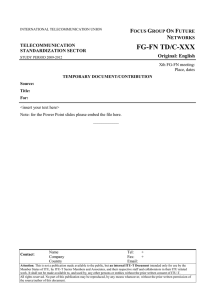
INTERNATIONAL TELECOMMUNICATION UNION
FOCUS GROUP ON FUTURE
NETWORKS
TELECOMMUNICATION
STANDARDIZATION SECTOR
FG-FN OD-37
Original: English
STUDY PERIOD 2009-2012
4th FG-FN meeting:
Tokyo, Japan, March 29-April 2, 2010
OUTPUT DOCUMENT 37
Source:
Editors
Title:
Draft text of “Terminology of Future Networks”
This is an initial text of “Terminology of Future Networks”, an output of 4th FG-FN meeting in
Tokyo, March 29 – April 2, 2010.
At this moment this is copy and paste of other FG-FN documents, e.g., FNvision, FNvirt, etc.
Contact:
Takashi Egawa
NEC Corporation
Japan
Tel:
+81 44 431 7770
Email: t-egawa[at]ct.jp.nec.com
Contact:
Chaesub Lee
ETRI
Korea (Rep. of)
Tel: +41764114871
Email: chae-sub.lee [at] ties.itu.int
Attention: This is not a publication made available to the public, but an internal ITU-T Document intended only for use by the
Member States of ITU, by ITU-T Sector Members and Associates, and their respective staff and collaborators in their ITU related
work. It shall not be made available to, and used by, any other persons or entities without the prior written consent of ITU-T.
All rights reserved. No part of this publication may be reproduced, by any means whatsoever, without the prior written permission of
the source/author of this document.
-2FG-FN OD-37
Terminology of Future Networks
Summary
This document describes the Future Network specific terms by copying the definitions defined in
other FG-FN documents.
EdNote: One possibility of future shape of this document is, terms are defined in this document and
other documents refer this document, i.e., do not define by themselves.
1. Scope
This document describes the future network specific terms.
2. Definition
Component network: A component network consists of a single homogeneous network, which by
itself does not provide a single seamless end-to-end global telecommunication infrastructure.
EdNote: Is clarification of “sing seamless” may be needed.
EdNote: from FNvision, section 2
Federation: Federation is a technology that enables a heterogeneous collection of component
networks to be operated as a single seamless network that shares network resources with other
networks, while the networks are geographically dispersed and managed by different providers.
Note: A federation of networks is sometimes known as a “network of networks”.
EdNote: from FNvision, section 2
Future Network (FN): A future network is a network which is able to provide revolutionary
services, capabilities, and facilities that are hard to provide using existing network technologies.
A future network is either:
a) a new component network or an enhancement to an existing one;
or
b) a federation of new component networks or federation of new and existing component networks.
Notes:
1 A network of type b) may also include networks of type a).
2 The label assigned to the final federation may or may not include the word “future” depending
on its nature relative to any preceding network and similarities thereto.
EdNote: from FNvision, section 2
-3FG-FN OD-37
Future Networks (FNs): Future Networks is a plurality of Future Network. It is usually used to
express that there may be more than one network that fits in the definition of “Future Network”,
EdNote: from FNvision, section 2
[Editor’s Note: Working definition of Identification is ‘procedures to identify objects.’ In ITU-T
Rec. F.851 and F.852, this term is defined as ‘A process to identify the UPT user or the UPT service
provider’, but we need our definition.
Some definitions of related terms:
Identifier: An identifier is a series of digits, characters and symbols or any other form of data used
to identify subscriber(s), user(s), network element(s), function(s), network entity(ies) providing
services/applications, or other entities (e.g., physical or logical objects). (ITU-T Rec. Y.2091 and
Y.2720)
Identity: Information about an entity that is sufficient to identify that entity in a particular context.
(ITU-T Rec. Y.2720)]
(EdNote: from top-page editor’s note of FNidentification)
New: In the context of this document the word “new” component network means that the
component network is able to provide revolutionary services, capabilities, and facilities that are
difficult or impossible to provide using existing network technologies.
EdNote: from FNvision, section 2
Network Virtualization: Network virtualization is the technology that enables the creation of
logically isolated network partitions over shared physical network infrastructures so that multiple
heterogeneous virtual networks can simultaneously coexist over the shared infrastructures. Also,
network virtualization allows the aggregation of multiple resources and makes the aggregated
resources appear as a single resource.
The virtual networks are completed isolated each other, so different virtual networks may use
different protocols and packet formats. When combined with programmability in network elements,
users of virtual networks can program the network elements on any layers from physical layer to
application layer. They can even define new layering architecture without interfering the operation
of other virtual networks. In other words, each virtual network can provide the corresponding user
group with full network services similar to those provided by a traditional non-virtualized network.
The users of virtual networks may not be limited to the users of services or applications, but may
include service providers. For example, a service provider can lease a virtual network and can
provide emerging services or technologies such as cloud computing service, and so on. The service
providers can realize the emerging services as if they own dedicated physical network
infrastructures. In order to facilitate the deployment of network virtualization, it may be necessary
to provide control procedures such as creating virtual networks, monitoring the status of virtual
network, measuring the performance, and so on.
Also, network virtualization can reduce the total cost by sharing network resources. One of
motivation of network virtualization is to achieve better utilization of infrastructures in terms of
reusing a single physical or logical resource for multiple other network instances, or to aggregate
multiples of these resources to obtain more functionality. These resources can be not only network
components, such as routers, switches, hosts, virtual machines, but also service elements, such as,
-4FG-FN OD-37
operation and measurement services, instrumental services, and so on.
Network virtualization on its own is quite a useful technology, but to gain the greatest benefit it will
be better to have a managed virtualization environment. Such management allows better control,
monitoring, and analysis of the virtualized environments.
EdNote: from FNvirt, section 2
EdNote: The texts below are placed to explain fundamental issues regarding FN.
Note 1: FN is still in the early R&D stage, and there is no concrete specification or enabling technology to
accommodate FN’s vision. Therefore, gap analysis between current networks and FN cannot be conducted at
this time. This document will be revisited when details of the technology is fully developed, to conduct
thorough gap analysis.
Note 2: It should be noted that FN can be based on IP technology or technology other than IP.
Bibliography
TBD




